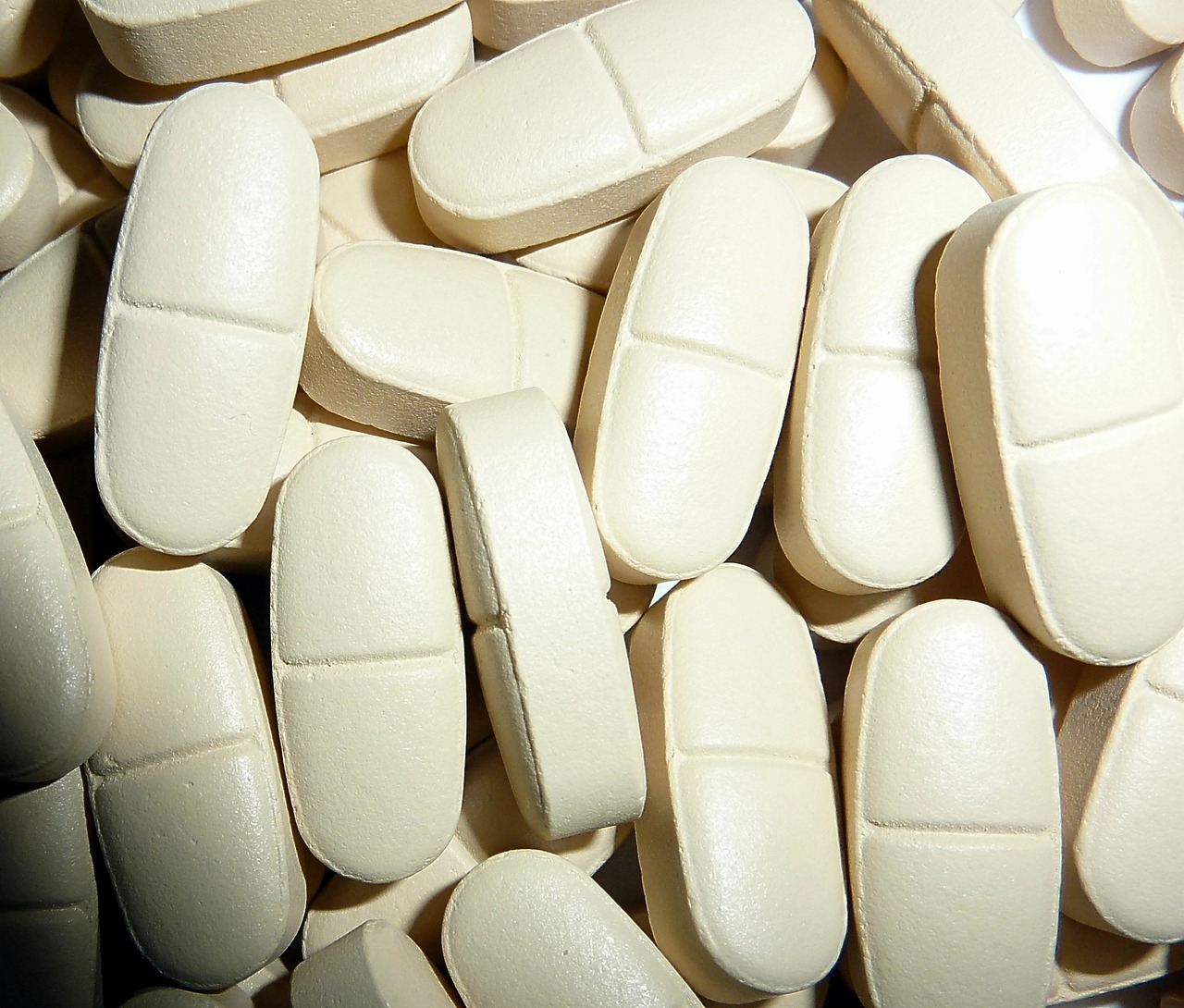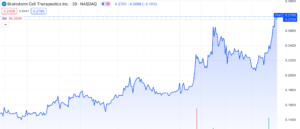BioPharma
Todos Medical (OTCMKTS: TOMDF) Heats Up as Tollovir 3CL Protease Inhibitor Moves Forward and Antibody, PCR testing & cPass Gain Traction
Published
4 years agoon
By
Tom Rieder
Todos Medical (OTCMKTS: TOMDF) has been on the move northbound in recent weeks on a steady surge of volume easily topping $1 million in dollar volume per day and emerging as a top traded stock in small caps. With recent highs of $0.1047 the stock needs to break north of this price point for confirmation of the next leg up.
TOMDF has many innovations in the testing space. One reason is their medical Advisor, Jorge Leon, who was the mind behind the regulatory strategy at Quest Diagnostics. They also have a breast cancer and an Alzheimer’s disease test. Their COVID-19 strategy was very interesting because they built up capacity preparing for the next wave while all the smaller labs went back to their normal business. As a result they are able to take on bigger clients and have the capacity. Just recently they were awarded a reference contract that brings in 1000 samples daily. This could translate into at least $20 million annually, but if they hit their anticipated surge capacity could be worth much more. Any surge in Omicron could send the existing business into exponential growth. They currently have the capacity to do up to 20,000 tests daily and were considering “the idea of purchasing more equipment to stay ahead of the curve.” The management is extremely bullish on the sector and added testing capacity when most thought the pandemic might be over.
Todos Medical (OTCMKTS: TOMDF) is at the same interim point in their clinical trials that PFE was at 6 weeks ago when the DSMB stopped the clinical trial of the 3CL protease inhibitor skyrocketing the valuation on the news. TOMDF also has a 3CL protease inhibitor, called Tollovir that is made from all natural ingredients and doesn’t have any dose level toxicity. In the coming weeks investors will see if the CEO was correct on his assessment of the drug as he was about the resurgence of COVID-19.
For more on TOMDF read the end of this article now lets look at the sector in general:
As the Omicron variant surges there are many industry uncertainties, but one constant. That constant is that COVID-19 testing will benefit regardless of which strategy policymakers, physicians, and pharma use to combat the new variant. If vaccines still retain some effectiveness, they will need to reassess the population and figure out who is protected and who isn’t so they can quickly bridge the gap until another vaccine is available to specifically combat the Omicron variant. Policymakers might also embrace expanded-use oral antivirals like Pfizer’s Paxlovid or Merck’s molnupiravir which only work early (< 5 days from infection) in the disease so finding these people early is the only way that strategy would be effective. Further, testing is critical for tracking Omicron and potential further variants. Testing is on track to make a huge comeback so investing in these names ahead of the curve could be a very profitable investment thesis.
Dismantling The Testing Network
Many of the pure play testing companies have been under considerable pressure because testing and controlling community spread for all intents and purposes was abandoned once the vaccines started to roll out en masse in Spring 2021. The general thinking was that with such high levels of vaccine protection from infection, it would do little good to keep testing as everyone would be protected regardless. The flaw in this concept was that analysts completely overestimated how good the vaccines were and how long this protection would last. A recent study confirmed that they were half right that surveillance testing would do little good if the vaccines were 95% effective, but were actually considerably useful once that level dropped down to 75% effectiveness.
People who had a shot 5-6 months ago have “almost no neutralizing ability against Omicron, a far cry from the initial 95% reduction in infection a year ago against the wild type virus. While the vaccines do offer some protection against hospitalization and death, it’s clear that the efficacy quickly wanes and those who want to remain protected from vaccines alone will need to be boosted every few months. This is such a short time frame that testing will be required for cases, variants, and immunity—having neutralizing antibodies.
Although there was a factual basis for stopping surveillance testing, once they started seeing breakthrough infections from the Delta variant, the administration was wrong to not ramp up the surveillance testing once again to protect Americans. There is a belief that this was done to mask the waning effect of vaccines so that they could continue their campaign to vaccinate more Americans in their quest for herd immunity. On May 10th the CDC stopped tracking breakthrough infections except those that resulted in hospitalization. Without data tracking all the increased number of breakthrough infections that don’t result in hospitalization, the vaccines were able to maintain a very high perceived efficacy rate until breakthrough infections from Delta pounded the nation and forced a pivot toward booster shots.
With the cat out of the bag, many vaccine-hesitant Americans are feeling as if they were right all along and the government is pushing mass vaccinations including vaccines for kids upon the entire population. Many parents feel the vaccines are unnecessary and also risky for kids since the long-term (years worth) effects of COVID-19 vaccines as well as mRNA technology have not been studied, while kids as a population are not at risk for developing severe COVID-19. The argument is that child vaccinations will slow the spread of COVID but that can effectively be done with testing without subjecting any kids to the potential risks of taking a biopharmaceutical product.
Many may have forgotten, but in the spring of 2021 daily infections dropped to as low as 4000 on June 20th, 2021 so the idea of millions of tests to control such a small number of nationwide cases was not widely supported. Based on the science, an argument can be made that the lack of testing infrastructure led to the widespread community spread of the Delta variant, which the vaccines were less efficacious against, in just a couple of months. The administration seems to have learned from its mistakes on testing, but it’s still too soon to gauge if they are serious about Omicron.
The vaccines were up to 95% effective against the Alpha variant, but what nobody knew was how long that protection would last, and that was ultimately the achilles heel of the vaccine only strategy that was eventually modified by a booster strategy that was modified recently by an additional booster strategy. The sad part is that a testing tool was available at the time to help keep the population’s immunity levels high through the use of boosters, as determined by a neutralizing antibody test. There currently exists an EUA approved cPass test that can be used to determine the level of neutralizing antibodies needed to combat Delta. Then a patient and their doctor can make their own decision based on actual data of whether each patient’s immunity is sufficient
Failed Promises on Testing Front Impacted Testing Stocks
When the new Administration came into office it put together some bold testing initiatives. Democratic Senator Tammy Baldwin introduced the $2.0 billion legislation that targeted 15% surveillance. In February 2021 the testing rate was between 0.3% to 0.5%. At the time, the United Kingdom had a similar goal to sequence about 10% of samples. The current estimate is 5-10% which represents a huge spread compared to the initial estimates measured in tenths of a percent. The large spread seems to be consistent with the lack of transparency surrounding any numbers related to vaccine effectiveness.
Promises were made as part of The America Rescue Plan to increase genomic testing from 7,000 samples weekly to 25,000 weekly. A couple months later, reports surfaced that that the $1.75 billion sequencing boom was inadequate. An article in the MIT Technology Review said
“On its site describing genomic surveillance, the CDC says that sequencing can track whether variants have learned to evade vaccines or treatments. But the agency’s surveillance sequencing program doesn’t connect any of its sequences back to the people they came from, whether they were vaccinated, or how sick they got.”
The article highlights that the mindset of the CDC was to show that the testing was done just to check a box in order to show that the United States was doing its part. However the spirit behind the testing was to try and catch variants early and the spirit of the program was not being honored. Only time will tell if the government is serious about doing everything in its power to combat COVID. The testing business suffered a big blow earlier this year in spite of big promises, but it seems that this go around the testing business is going to ramp up again with or without government backing because all paths forward require testing.
Rapid Tests, PCR Testing, & Neutralizing Antibodies
Abbott Labs is perhaps the best known testing company as it has shipped over a billion tests since the start of the pandemic and brought in billions of COVID-19 testing revenue just last quarter alone. The company has a $237 billion market capitalization and supports 9 different COVID-19 tests, from molecular (like PCR) or antigen to serology (antibody) tests.
Labcorp has a self collection kit for RT-PCR. It’s a nasal swab that is also approved for kids. It’s free if insurance covers it and involves sending the kit FEDEX and then the person can ship it back. They also have collocated with Walgreens locations in 32 states throughout the country. They also have antibody test kits that are semi-quantitative in nature. They also have genomic testing to determine the variant. However much of their business comes from schools, universities, and employers looking to keep their workforce safe. They boast 275k molecular test capacity daily. They had total revenues of $4.1 billion and revenues of over $2.5 billion quarterly in just the testing space. They also have many other tests in oncology and are a major part of much of the testing done in clinical trials. Their total market cap is $27.6 billion. Since vaccine mandates recently failed they may be a beneficiary as larger organizations require additional testing.
Quest Diagnostics is an outsourced solution for hospitals so that they can eliminate the cost of an in house lab. The company also has a number of proprietary testing panels. They have a big exposure in COVID-19 with a direct to consumer push called QuestDirect. They have a huge geographic footprint that includes their own centers but also Walmart locations. This allows them to take online orders and push them to their locations to conduct the tests and get reimbursement from the government. In their third quarter earning call they commented how sales softened during the summer when COVID-19 was approaching its lows. The company’s market capitalization is $20 billion.
Quidel is a rapid diagnostic testing provider generating revenues of $510 million per quarter. They are best known in the market for their QuickVue At-Home OTC Covid-19 test. QuickVue is an anterior nasal swab antigen test. Thankfully, the company has mentioned its antigen test remains accurate for Omicron, as antigen tests are theoretically subject to error if a mutation changes an antigen within the protein being tested for. The company’s market cap is $5.6 billion.
Lumira DX developed a Point of Care (POC) diagnostic that uses nasal swabs and a proprietary compact reader to quickly process samples and distribute results. It has a $2.3 billion market cap. In the latest quarter it reported $109.1 million in revenue and seemed to be averaging $100 million per quarter for the past 3 quarters. An increase in testing in the United States and European markets is sure to have a positive effect on the company. It’s also important to point out to investors that this company was also backed by Bill & Melina Gates.
Small Cap Opportunities
Applied DNA Sciences is very diversified in the COVID-19 testing space. They perform surveillance testing and they have made diagnostic kits with EUA approval. They are also using their kits to monitor the S-gene mutation which appears to be a hallmark of the Omicron variant. In their 4th quarter report they reported testing revenue grew 868% year over year and closed the year with $9.0 million in total revenue. The CEO was very bullish on testing and said
“Momentum in COVID-19 testing client acquisition, especially in the second half of the fiscal year, supported our continued investment in ADCL that is now largely complete…Average weekly testing levels remain in flux but are on an uptrend: new clients are onboarding in FQ1; the key client’s testing needs have increased since Thanksgiving to include the random testing of vaccinated individuals.“
They have a strong intellectual property base of 93 patents which also includes their Linear DNA manufacturing platform. They can also genetically tag cotton for the textile industry, different cannabis strains, fertilizer, and even inkjet codes to ensure their authenticity in the supply chain. They have net equity of $11 million which places their enterprise value at $25 million. Their market cap is only $36 million with lots of upside catalysts.
XpresSpa Group performs COVID-19 testing at 14 major airports. They do onsite tests right at the airport. They charge $75 for a standard PCR test available in a couple of days or $250 for the rapid PCR tests available in 60 minutes. Their core business pre-covid were those massage chairs that you may have seen in the airport terminals. It’s called XpressSpa and they had 43 locations in 21 airports. Many locations did close but are starting to reopen. They have a strong cash position with $109 million which represents over $1.00/share in cash and just turned a profit of $22 million. They have a market cap of $187 million yet their enterprise value is only $90 million. They have huge margins in their business and have one of the best locations where they have a monopoly on the customer. Their footprint may grow as the government agencies vie for more testing at the points of entry. The company is also seeing that testing may be sticky and be here for a while and that is leading them to get spots in the pre security airport space. In a recent fireside chat with Water Tower Research. The CEO said they “were on track to have a record breaking fiscal year.” The risk to reward profile is very high in this name as it is relatively undiscovered.
Co-Diagnostics is a business founded upon a new technology that makes PCR tests more accurate. As such, it became a very popular COVID-19 stock in the early days of the pandemic, with the stock languishing within the last year with the rest of the biotechnology sector, but also due to the lack of focus on testing. The company is guiding for just under $100 million in revenue for the year, and had its Logix Smart™ COVID-19 2-Gene Test recently approved in the UK. The company’s business could be set for major growth as testing comes back into play. The company’ market cap is sitting at $245 million.
TODOS for cPass
Todos Medical actually supports a wide range of tests for having a smaller market capitalization of $65 million. The company provides antibody and PCR testing services as well as a neutralizing antibody test called cPass which is actually the only FDA emergency use authorized (EUA) test to determine a person’s existing immunity through neutralizing antibodies, which are the only antibodies you want to have for protection. cPass was developed by GenScript, and Todos has entered a distribution agreement with Fosun Pharma, a fairly large Chinese pharma company, for the test. Many vaccinated people were unsure if they needed a booster or not because everyone’s immune system is different and it actually not a good idea to poke the immune system unnecessarily. While policy makers were debating the durations of boosters (5 months, 6 months or 8 months) informed doctors were recommending their patients take cPass so they can evaluate their level of protection against the new variants. With the Omicron variant its likely that a very high level is going to be needed to neutralize the variant which means the cPass will be vital should the vaccines afford protection against it. It will be weeks before that data trickles down.
Future Tollotest
When the virus enters the cell the first thing it does is make 3CL protease. The ratio is 70 protease to 1 spike protein which means that it is a very early indicator of infection. Recent studies have shown that it can detect infection as early as 1-3 days with 100% sensitivity. The current at-home blood antigen tests take 9 days to show infection making it very difficult to capture people at early stage disease where the oral antivirals are most effective. The only issue with the test is that the 3CL protease is common to a number of coronaviruses including the common cold and influenza. While this is a great mass screening tool another test is going to be needed to determine COVID-19. The test can also determine if a person is no longer infectious which would allow people to return to their duties when they are no longer infected instead of a specified quarantine duration of 7- 10 – 14 days depending on the jurisdiction. The presence of the 3CL protease indicates active infection and TOMDF is trying to optimize the test for different point of care (POC) assays including the lateral flow tests that resemble the finger prick blood tests. Once optimized the will perform the necessary studies to submit an EUA. This test alone could really be a very valuable tool in trying to eradicate COVID-19 by allowing us to treat it sooner. Early detection is one of the key strategies in combating cancer and those lessons learned can be easily applied to COVID-19.
To Find out the inside Scoop on TOMDF Subscribe to Microcapdaily.com Right Now by entering your Email in the box below
Todos Medical
Todos Medical (OTCMKTS: TOMDF) has many innovations in the testing space. One reason is their medical Advisor, Jorge Leon, who was the mind behind the regulatory strategy at Quest Diagnostics. They also have a breast cancer and an Alzheimer’s disease test. Their COVID-19 strategy was very interesting because they built up capacity preparing for the next wave while all the smaller labs went back to their normal business. As a result they are able to take on bigger clients and have the capacity. Just recently they were awarded a reference contract that brings in 1000 samples daily. This could translate into at least $20 million annually, but if they hit their anticipated surge capacity could be worth $100 million. Any surge in Omicron could send the existing business into exponential growth. They currently have the capacity to do up to 20,000 tests daily and were considering “the idea of purchasing more equipment to stay ahead of the curve.” The management is extremely bullish on the sector and added testing capacity when most thought the pandemic might be over.
The CEO is very knowledgeable and articulate and has written a number of articles on COVID-19 and has made a number of TV appearances including FOX Business. What investors need to realize is that TOMDF is much more than a testing company because it has a very big biotech component. They have a binary event in the coming weeks as they are expecting a readout on their Phase 2 clinical trial of Tollovir in hospitalized patients. There were quite a few tells in a Benzinga video interview the results are expected to be excellent. The CEO stopped short of taking pot shots at both the Pfizer and Merck drugs saying that “we have a significant competitive advantage.”
This pharmaceutical component might be very attractive to biotech investors but it also represents risk. The company has a definitive deal to close their acquisition of the biotech NLC pharma and that could represent a burden with respect to dilution. The company is also working on uplisting to the NASDAQ and has a plan in place to clean up the legacy debt and fund expansion going forward.
The company is at the same interim point in their clinical trials that PFE was at 6 weeks ago when the DSMB stopped the clinical trial of Pfizer’s 3CL protease inhibitor skyrocketing the valuation on the news. TOMDF also has a 3CL protease inhibitor, called Tollovir that is made from all natural ingredients and doesn’t have any dose level toxicity. In the coming weeks investors will see if the CEO was correct on his assessment of the drug as he was about the resurgence of COVID-19.
The company also has a nutraceutical line called Tollovid that is gaining traction and just saw a $1.1 million licensing agreement but then also messaged that they were talking to others. The company indicated that sales were upticking as people started to connect the dots that the 3CL protease was the same target in Paxlovid.
TOMDF has 914 million shares outstanding and very little in the way of cash as it is tied up in receivables in the testing business. It’s reasonable to suspect the company will do another round of financing unless their revenues in the testing business overwhelm them in the near term. They have messaged the market they are waiting for a value inflection point to raise additional funds. If they have good results with their oral antiviral Tollovir it could allow them to raise money on very favorable terms in the near future which would be a tremendous catalyst for the stock.
Investment Summary
For investors that believe that Omicron is going to surge throughout the world it’s very clear that increased testing is going to be a key part of the narrative. Many of the big names in testing are highly correlated and a safe bet for price appreciation. The biggest unknown in the testing business is which type of test is going to see the highest levels of adoption. That is going to be primarily driven by policy and it’s too soon to handicap which way the wind is going to blow and if the government is going to continue to subsidize testing the way they have in the past. The government seems to be pushing insurance providers to reimburse their customers for at-home COVID-19 diagnostic tests. Details from Biden’s new initiatives are still emerging, but it’s hard to imagine incentives that would reduce testing. Big names like ABT, LH, and DGX are already moving higher.
Investors interested in taking on a larger risk for potential higher reward should be interested in the smaller companies rather than the gargantuan. Small and microcap companies such as CODX or TOMDF are going to see much greater relative increases in business as they rapidly increase their testing volumes.
Todos Medical is arguably the better bet as its market cap is well below that of Co-Diagnostics’ and it is due to release phase 2 results from its 3CL protease inhibitor, Tollovir, which is expected to rival the fantastic results of Paxlovid, the big pharma’s COVID-19 antiviral that beat efficacy expectations by a wide margin. Investors have multiple shots on goal with Todos—multiple types of tests and testing business, the antiviral, and their nutraceutical.
Disclosure: we hold no position in TOMDF APDN XSPA or CODX either long or short and we have not been compensated for this article.
You may like
-


Bioxytran (OTCMKTS: BIXT) Peer-Review Published Showing Functional Cure for COVID-19
-


Todos Medical (OTCMKTS: TOMDF) Interviews Reveal Major Testing Plans
-


Todos Medical (TOMDF) & CYDY are Two Biotech Plays to Watch Monday After the Merck Expose
-


Top Covid Stocks In Play After Pfizer Vaccine Approval: TOMDF ENZC TSOI
BioPharma
Brainstorm Cell Therapeutics’ (NASDAQ: BCLI) Post-Setback Resurgence: Unpacking FDA Impact & Market Expectations
Published
2 years agoon
November 30, 2023
Brainstorm Cell Therapeutics (NASDAQ: BCLI) continues to gain momentum with a surge of over 125% since its low on October 31st, 2023. Following an unfavourable FDA decision on its ALS treatment, the stock hit an all-time low of $0.13 per share. Nethertheless, the stock experienced a significant rebound today, November 30th, 2023, rising by 26%, without accompanying press releases or SEC filings.
This resurgence prompts us to evaluate the possibilities for yet another company struggling to meet NASDAQ’s minimum bid requirements. A closer examination of recent months reveals intriguing developments that might pique the interest of potential investors. Our findings suggest BCLI holds promising near term prospects that could significantly alter its course.
Background:
BCLI specializes in developing therapies that utilize a patient’s own stem cells to combat severe neurodegenerative ailments like Amyotrophic Lateral Sclerosis (ALS) and progressive Multiple Sclerosis (MS). ALS affects nerve cells in the brain and spinal cord, while MS affects the central nervous system, causing problems with vision, balance, and muscle control.
The company holds exclusive global rights for the clinical advancement and commercialization of the NurOwn® technology platform, enabling the production of autologous MSC-NTF cells. These cells have received significant recognition and were awarded Orphan Drug designation by both the FDA and the European Medicines Agency (EMA).
Autologous MSC-NTF cells:
The way Autologous MSC-NTF cells work is very interesting. They’re a specific cell type obtained from an individual’s mesenchymal stem cells (MSCs). These cells are then genetically altered to produce neurotrophic factors (NTFs), which are designed to support and stimulate the growth and survival of nerve cells within the nervous system.
BrainStorm has conducted a Phase 3 clinical trial (NCT03280056) investigating the safety and effectiveness of multiple doses of autologous MSC-NTF cells for ALS. This trial received support from the California Institute for Regenerative Medicine, the ALS Association, and I AM ALS. Additionally, the company completed a Phase 2 open-label multicenter trial (NCT03799718) for progressive MS using these cells, backed by a grant from the National MS Society (NMSS).
Back to Square One:
Unfortunately for BCLI, 17 FDA advisory panel members voted that the data presented for their Phase 3 clinical trial for ALS did not demonstrate substantial evidence of the effectiveness of NurOwn for the treatment of mild-to-moderate ALS. There was simply only one member who voted in favour and another member that abstained from voting entirely.
Predictably, this resulted in a substantial downturn in the company’s share price, causing BCLI to plummet 87% below NASDAQ’s minimum bid compliance threshold of $1.00.
Subscribe to Microcapdaily.com Right Now by entering your Email in the box below.
Subscribe to Our 100% Free Penny Stock Newsletter. We Have Something Big Coming!
Is it Over?:
To those not well-versed in this matter, it might appear as if BCLI is forced to throw in the towel and start everything from scratch, but the reality is actually quite different.
When a drug fails in clinical trials, the pharmaceutical company or researchers typically reassess the data to understand why the drug failed.
They might conduct further analysis to determine if there were unforeseen side effects, issues with the study design, or if the drug simply didn’t show the desired effectiveness. They’ll work to make adjustments, refine the drug’s formulation, or in some cases, explore other alternatives by re-designing new clinical trials to evaluate the drug’s safety & efficacy for a different condition.
If none of those efforts yield a positive outcome, it’s typical to halt further development of that specific drug.
Regardless of the FDA’s decision, Co-CEO Lindborg mentioned, “We firmly believe that the data for NurOwn presented today provide a compelling case for approval, with clinical evidence in those with less advanced disease supported by strong and consistent biomarker data that are predictive of clinical response,”
Unfortunately for Lindborg, the decision does not rest with her. A panelist from the FDA, Lisa Lee, expressed, “Providing false hope can be ethically problematic and false hope is provided when the probability of a positive outcome is overestimated. And I think that seems to be the case here.”
After the devastating press release on September 27th, 2023, most of the retail crowd was on board with the FDA, mentioning it was time for BCLI to pack up, and go home – especially after seeing these comments from the FDA.
What Happened:
Amid FDA skepticism and investor uncertainties, BCLI took decisive action, securing a chance for a new phase 3 trial to showcase the effectiveness and safety of their NurOwn® technology for ALS treatment.
On October 24th, 2023, BCLI issued a press release affirming their conviction in the compelling data and expressing their intent to further substantiate it to the FDA.
More specifically, this was a “Strategic realignment” designed to:
- Support the company plans to conduct a double-blind, placebo-controlled Phase 3b U.S. clinical trial for NurOwn in ALS with an open-label extension and
- Continue to publish data from NurOwn’s Phase 3 clinical trial on biomarkers, long-term safety, survival, and the Expanded Access Program, providing transparency around NurOwn data and progressing ALS drug development.
Big Release:
Then on November 20th, 2023, BCLI issued another press release, stating that the FDA granted them an in person meeting to discuss the regulatory path forward for NurOwn® in ALS.
Within’ the last month or so, it appears the market is HIGHLY anticipating the outcome of this meeting, given it is now scheduled to take place on December 6, 2023.
This meeting allows BCLI to have a Special Protocol Assessment (SPA) with the FDA to agree on the overall protocol design for a confirmatory Phase 3 trial in ALS.
If you aren’t familiar with a SPA, it’s an agreement between a pharmaceutical company and the FDA regarding the design, endpoints, and size of a clinical trial intended to support a New Drug Application (NDA) or Biologics License Application (BLA). This agreement aims to confirm that the trial design, data analysis, and endpoints are acceptable to the FDA for the regulatory approval process.
A favorable result from this meeting could greatly benefit BCLI, paving the way for the actual launch of NurOwn®. This outcome stands in stark contrast to the prior belief, post the September 27th, 2023 news, which led many to assume otherwise.
If the trend remains positive, BCLI could see a significant surge in valuation, given the substantially reduced risk associated with a drug nearing commercial availability.
Conclusion:
Boosting the optimism for December 6th is the heightened enthusiasm among retail investors surrounding the company. Some speculate that the surge might mirror what SNGX experienced today, on November 20th, 2023. With technical day traders and swing traders in the mix, many perceive this as the final opportunity to join the trend before it gains further momentum. It’s crucial to remain vigilant as December 6 approaches rapidly, potentially ushering BCLI into an entirely altered and positive scenario.
We will update you on BCLI when more details emerge, subscribe to Microcapdaily to follow along!
Subscribe to Our 100% Free Penny Stock Newsletter. We Have Something Big Coming!
Disclosure: We have not been compensated for this article/video. MicroCap Daily is not an investment advisor; this article/video does not provide investment advice. Always do your research, make your own investment decisions, or consult with your nearest financial advisor. This article/video is not a solicitation or recommendation to buy, sell, or hold securities. This article/video is our opinion, is meant for informational and educational purposes only, and does not provide investment advice. Past performance is not indicative of future performance.
Picture by ckstockphoto from Pixabay.com
BioPharma
Apollomics (NASDAQ: APLM) Market Momentum: Pipeline Potential, Market Trends, and Retail Insights
Published
2 years agoon
November 27, 2023
Apollomics, Inc. (NASDAQ: APLM) has seen a significant surge in its shares, rising by ~20% at time of writing, accumulating a staggering 58% gain since November 21st, 2023. Surprisingly, there haven’t been any noticeable press releases or filings to explain this sudden valuation shift, so it’s prompted a closer examination on our end. Fortunately enough, we found the force driving the substantial gain, but first let’s look into APLM’s background to build a better picture of the opportunity at hand.
 Background:
Background:
APLM’s emergence as a public company is relatively recent, stemming from its merger with Maxpro Capital Acquisition Corp. (Nasdaq: JMAC) on March 30th, 2023. This merger also involved a $23.65 million private investment in public equity (PIPE) financing, a typical move when companies go public, aiming to secure capital. With this recent funding, APLM anticipates financial support through mid-2024, empowering the company to push forward with its ambitious lineup of 9 drug candidates.
APLM stands as an innovative player in the field of clinical-stage biopharmaceuticals, specializing in crafting cancer therapies that work hand-in-hand with the immune system and target precise molecular pathways to combat cancer. With a focus on oncology, the company boasts a lineup of nine potential drug candidates, six of which are actively progressing through clinical development stages.
Among its flagship projects are vebreltinib (APL-101), a potent c-MET inhibitor that targets multiple forms of non-small cell lung cancer (NSCLC), and uproleselan (APL-106), an E-Selectin antagonist designed to potentially enhance standard chemotherapy in treating acute myeloid leukemia.
Latest Release:
APLM recently announced significant news concerning its Chinese partner, Avistone Biotechnology, on November 11th, 2023. Avistone received conditional approval from China’s National Medical Products Administration (NMPA) to market vebreltinib. This medication is intended for treating a particular type of lung cancer known as MET exon 14 skipping non-small cell lung cancer (NSCLC).
Dr. Guo-Liang Yu, Apollomics’ leader, praised Avistone for this achievement, saying it’s a big step toward finding better treatments for tough cancers. Vebreltinib is a powerful medicine that targets how cancer cells grow. It could be a breakthrough for people with this specific lung cancer and other cancers caused by similar changes in cells.
Apollomics is talking with the U.S. Food and Drug Administration (FDA) about using vebreltinib to treat this kind of lung cancer in the U.S. They’re using data from their global study and Avistone’s study in China to do this.
It’s no secret, Lung cancer is a big problem, especially for people with non-small cell lung cancer (NSCLC), which is responsible for most lung cancer cases. This specific mutation has a significant unmet need, and APLM’s vebreltinib could be hope for those battling the devastating disease.
Subscribe to Microcapdaily.com Right Now by entering your Email in the box below.
Subscribe to Our 100% Free Penny Stock Newsletter. We Have Something Big Coming!
Market Opportunity:
To keep things simple, we’ll continue focusing on APLM’s Vebreltinib (APL-101), which is just 1 of 9 drugs in their pipeline.
This specific drug, cultivated through a collaboration with Beijing Pearl Biotechnology (now merged with Avistone Biotechnology), appears to display considerable potential. Its appeal lies in its demonstrated safety, effectiveness, and its potential to address a specific market segment where there’s a significant demand for treatments due to unmet medical needs.
Vebreltinib (APL-101):
APL-101 is being evaluated for its potential use in combating specific types of Non-Small Cell Lung Cancer (NSCLC), and a particularly aggressive form of brain cancer, secondary glioblastoma multiforme (sGBM).
APL-101 is a Type 1b class highly selective c-MET inhibitor. More simply put, it’s a drug that effectively targets and blocks the c-MET protein.
c-MET inhibitors have a wide potential range of markets due to the involvement of the c-MET pathway in various cancers and other diseases. The c-MET receptor, also known as the hepatocyte growth factor receptor (HGFR), plays a crucial role in cell growth, survival, and migration. Dysregulation of the c-MET pathway is associated with tumor growth, metastasis, and resistance to certain therapies in multiple cancer types.
Outside of NSCLC and sGBM, Apollomics has already seen promising effects inhibiting tumors related to certain types of cancers like gastric, hepatic, and pancreatic. But to keep things simple, we’ll stick to Apollomics core focus in NSCLC and sGBM.
The Market:
According to statistics published by the World Health Organization (WHO) from February 2022, 2.2 million patients were diagnosed with lung cancer in 2020, and non-small cell lung cancer accounted for nearly 85% of all lung cancer patients.
The global non-small cell lung carcinoma (NSCLC) market is expected to garner a market value of US$ 8.25 Billion in 2023 and is expected to accumulate a market value of US$ 21.40 Billion by registering a CAGR of 10% in the forecast period 2023 to 2033.
Delving deeper into particular types of NSCLC, the market potential for Exon-14 skip mutated NSCLC, c-MET amplifications in NSCLC (denovo), and c-MET amplifications in NSCLC (resistance driven) collectively represents a 3 billion-dollar opportunity.
In contrast, the market size for the population affected by epidermal growth factor receptor (EGFR) mutated NSCLC stands at a larger 7 billion-dollar opportunity.
Subscribe to Microcapdaily.com Right Now by entering your Email in the box below.
Subscribe to Our 100% Free Penny Stock Newsletter. We Have Something Big Coming!
SPARTA Trial:
SPARTA is part of a larger study combining Phase 1 and Phase 2 trials, conducted in 13 countries, 90+ sites and 370+ patients worldwide. It aims to understand how safe and effective vebreltinib is in treating various cancers. More specifically, it’s looking at non-small cell lung cancer (NSCLC) with a specific genetic mutation called c-MET exon 14 skipping, as well as other cancers with c-MET amplification or fusions.
The trial involves different groups of patients: those new to treatments targeting the c-MET protein and those who have previously received such treatments for NSCLC with the mutation. Additionally, it includes patients with various solid tumors showing c-MET amplifications or fusions, including glioblastoma multiforme, a severe type of brain cancer.
The main goal of SPARTA is to measure how well vebreltinib works by assessing the overall response rate (ORR) and how long the response lasts (duration of response) using specific evaluation criteria for each type of tumor. Secondary goals involve looking at any side effects and additional measures like time to progression, progression-free survival, and overall survival.
Overall the clinical findings show that vebreltinib could be a promising new treatment for cancers caused by MET alterations, especially in Non-Small Cell Lung Cancer (NSCLC) with MetEx14 skipping mutation. In a phase 2 trial, there was 75% overall response rate in patients with advanced NSCLC.
If you’d like more formal clinical trial information for vebreltinib, it’s is available on clinicaltrials.gov under the Phase 1/2 SPARTA trial (NCT03175224).
Big Picture:
This is just 1 of 9 drugs in APLM’s pipeline, and APL-101 is just 1 of 2 key assets. With our initial examination of the company, we were taken aback by the comparatively low valuation despite the promising pipeline. Like many, there has been a considerable decline in share value since their public listing.
Now that China’s National Medical Products Administration (NMPA) has given conditional approval, the company intends to get Vebreltinib (APL-101) approved in the U.S. and has met with the FDA in July. With an existing approval by the NMPA, receiving the NDA Approval from the FDA should realistically be a much quicker process.
On top of this, more interesting developments have occurred from online sources, indicating substantial short activity, further hinting at the possibility of APLM being the next big short squeeze candidate.
What Happened & Retail Insights:
APLM seems to be gaining attention across various social media platforms, notibly Twitter and Reddit.
Numerous investors are discussing on different platforms that APLM might become a potential candidate for a short squeeze. Users have pointed out that the cost to borrow shares has risen significantly. This increased short activity seems to have also led to a shortage of available shares to borrow.
Increased buying activity is likely to intensify the pressure on short sellers, compelling them to buy back shares to cover their positions. Given today’s substantial surge in trading volume, short sellers may find themselves in a tight spot, potentially regretting their initial choice to wager against APLM.
We came across additional analysis (due diligence) about APLM on Reddit, providing concise insights. This is but one piece of content that’s drawing increased interest in the stock among retail investors.
APLM – Apollomics Inc- DD THREAD – BIO STOCK –
byu/StockProfilers inpennystocks
In recent times, Reddit has become a hub for discussions regarding stocks and potential market movements. It gained particular prominence in 2020 as a platform for detailed research and discussions about stocks, witnessed notably during the retail trading frenzy involving stocks like GME (GameStop) and AMC (AMC Entertainment Holdings).
Analyst Ratings:
Two analysts have set notably optimistic price targets for APLM, suggesting it might reach $21.00, representing a potential 1650% increase from its current value. Additional sources offer different projections, with estimates of $11.00 (an 816% increase), $14.00 (a 1066% gain), and $17.00 (a 1326% rise). It’s crucial to understand that analyst ratings are not certainties but rather projections based on their research. We commonly advise examining past coverage to assess the accuracy of analysts’ ratings and forecasts.
Conclusion:
In summary, APLM experienced a substantial surge, seemingly fueled by retail investors countering short sellers. However, beyond the retail-driven buzz speculating a potential short squeeze akin to TPST, a deeper narrative unfolds, signalling a compelling long-term proposition.
APLM’s pipeline exhibits fairly de-risked assets and promising data across multiple indications, not to mention large amount of partnership opportunities.
Analyst forecasts reflect a highly optimistic outlook, echoing positive retail sentiment. The ongoing SPARTA trial also unveils compelling data, suggesting a more profound story from a long term perspective.
Is APLM set for a short squeeze akin to TPST? Time will tell…. Nonetheless, within this realm, APLM seems fundamentally undervalued, making it a stock to keep a close eye on as more developments arise.
We will update you on APLM when more details emerge, subscribe to Microcapdaily to follow along!
Subscribe to Our 100% Free Penny Stock Newsletter. We Have Something Big Coming!
Disclosure: We have not been compensated for this article/video. MicroCap Daily is not an investment advisor; this article/video does not provide investment advice. Always do your research, make your own investment decisions, or consult with your nearest financial advisor. This article/video is not a solicitation or recommendation to buy, sell, or hold securities. This article/video is our opinion, is meant for informational and educational purposes only, and does not provide investment advice. Past performance is not indicative of future performance.
BioPharma
Processa Pharmaceuticals (NASDAQ: PCSA): Revolutionizing Cancer Treatment through Next-Generation Chemotherapies
Published
2 years agoon
November 23, 2023
Processa Pharmaceuticals’ (NASDAQ: PCSA) shares skyrocketed by over 260% from their October lows of $0.18 per share. Shares peaked at $0.65 on November 14th and more recently has consolidated around $0.43. The reason for this surge was not immediately clear given the lack of material events. However upon digging deeper, we’ve uncovered a very interesting aspect driving the sudden rise. Let’s take a closer look at their pipeline and company history to understand what potential developments might be on the horizon and whether the current levels are justifiable.
 Background:
Background:
PCSA is a clinical stage Pharmaceutical company that’s working to create better versions of chemotherapy that’s safer and more effective. More specifically called, “Next Generation Chemotherapy” or NGCs for short – they’re essentially just modified versions of existing FDA-approved oncology drugs.
The objective is of course to improve clinical outcomes and have less adverse events (AEs). They do this through altering the metabolism and distribution of the drug while maintaining the main mechanism that kills the actual cancer cells.
It’s all based off over 30 years of drug development expertise. Although efficacy and safety can vary drastically depending on the type of chemotherapy, it’s widely known that undergoing chemo is undeniably challenging for patients due to the potential negative impact on their well-being.
PCSA has a few clinical drugs that are based on Capecitabine, Gemcitabine, and Irinotecan.
Respective problems that occur with these drug treatments:
- Low treatment response with high side effect profile.
- High drug resistance and/or acquired resistance; administered as IV
- Significant side-effect profile limits dosing and drug use.
PCSA is actively working to achieve:
- Actively minimizing Adverse Events (AEs), consequently broadening the patient base.
- Developing an oral therapy that accelerates the action of cancer-killing molecules while enhancing their quantity to mitigate drug resistance.
- Ensuring that cancer-killing molecules selectively enter cancer cells rather than normal cells, enhancing effectiveness and reducing toxicity.
Subscribe to Microcapdaily.com Right Now by entering your Email in the box below.
Subscribe to Our 100% Free Penny Stock Newsletter. We Have Something Big Coming!
What Happened:
We took a closer look at PCSA’s SEC filings and found something interesting: in October, there were a lot of Form 4 submissions. This seems to be the main reason for the sudden increase in PCSA’s valuation. Between October 10th and October 12th, insiders bought over 590,000 shares, and it wasn’t just one person—several insiders made these purchases. More often than not, this suggests a high expectation for something big happening soon.
Management Team:
Another important aspect to consider is the leadership team. It’s a fundamental step in conducting your due diligence since past achievements and expertise often pave the way for future success. Let’s swiftly overview just two key individuals in the company. For more information on others, click here.
George Ng | CEO:
Mr. Ng is a highly experienced figure in the life sciences industry with an extensive career involving founding and leading various companies. Notably, at Scilex Pharmaceuticals, Inc. (now, Scilex Holding Co (NASDAQ:SCLX)), where he played a key role in the company’s journey from development and clinical trials to NDA submission, FDA approval, a substantial $140 million financing round, the successful commercial launch of their first FDA-approved drug product, and the ultimate sale of the company. His career history includes a range of senior management positions across globally recognized biotechnology and pharmaceutical companies like Sorrento Therapeutics, Inc. (NASDAQ: SRNE), BioDelivery Sciences International, Inc. (NASDAQ: BDSI), Spectrum Pharmaceuticals, Inc. (NASDAQ: SPPI), and Alpharma, Inc. (NYSE:ALO), which is now part of Pfizer Inc. In these roles, Mr. Ng played pivotal roles in strategy, development, fundraising, and the commercialization of multiple pharmaceutical drug products.
David Young | President, Research & Development:
Dr. Young possesses extensive expertise in pharmaceutical research and development, spanning over three decades. As the Chief Scientific Officer of Questcor Pharmaceuticals from 2009 to 2014, he collaborated with the FDA to modernize Acthar Gel’s label and secure FDA approval for Infantile Spasms. His impactful involvement contributed significantly to Questcor’s transformation from near bankruptcy in 2007 to an esteemed orphan drug specialty company, reaching a valuation of around $5.6 billion by 2014. He was also the Founder and CEO of GloboMax LLC, a CRO specializing in FDA drug development that was purchased by ICON plc in 2003. Preceding his tenure at GloboMax, Dr. Young held a tenured Associate Professor position at the University of Maryland School of Pharmacy, leading a team of 30 individuals dedicated to evaluating the biological properties of drugs and drug delivery systems in both animals and humans.
Young’s experience extends even further: he served on FDA Advisory Committees, played a key role in an FDA-funded Clinical Pharmacology contract, oversaw the evaluation of oral products in a UMAB-FDA contract leading to FDA Guidance improvements, educated FDA reviewers for five years, participated in NIH grant review committees, and co-led a National Cancer Institute contract evaluating new oncology drugs.
Overall, Young’s met more than 100 times with the FDA on more than 50 drug products and played a vital role in over 30 NDA/supplemental NDA approvals. Additionally, he has over 150 published works, including presentations to the FDA, and numerous talks at scientific and investment gatherings.
It’s certainly significant that someone with such vast experience as Dr. Young is associated with PCSA, valued at ~10M at time of writing. Considering this executive’s extensive background in navigating FDA approvals, we hold a strong positive outlook on its potential trajectory. Dr. Young’s substantial insider purchases also strongly hint at positive developments ahead.
Subscribe to Microcapdaily.com Right Now by entering your Email in the box below.
Subscribe to Our 100% Free Penny Stock Newsletter. We Have Something Big Coming!
Phase 1B Trial Update:
The last Phase 1B trial update is written in a fairly scientific format, so we’ve taken the liberty of simplifying the release to better your understanding.
The Phase 1B trial of NGC-Cap in patients with gastrointestinal cancer aims to create a personalized treatment method that could be safer and more effective.
NGC-Cap is a treatment that mixes PCS6422, which stops an enzyme called DPD, with small amounts of a common chemotherapy drug, capecitabine. This chemotherapy drug turns into 5-FU in the body. DPD helps change 5-FU into another substance called FBAL, which usually causes strong side effects, making it tough to give higher doses of the chemotherapy treatment.
Processa discovered that regularly checking DPD levels, (shown by the substance FBAL), could help understand how each patient reacts to different NGC-Cap doses. This information might help doctors create specific treatment plans for each patient, aiming to reduce side effects and make the treatment work better while keeping the patient safe and comfortable.
Capecitabine is among the most widely used chemotherapy drugs and is dosed based on a standard dosage regimen for all patients. That said, many patients cannot tolerate that dose and must either have their dose reduced or have their treatment interrupted, which means ultimately means it’s less effective overall.
The discoveries made in this interim data is very promising and could mean that PCSA is now capable of personalized treatment plans, helping patients potentially handle the treatment much better without AEs.
Key Catalysts and Considerations:
There’s supposedly more updates soon for PCSA’s two main drugs, PCS6422/NGC-Cap and PCS3117/NGC-Gem.
For PCS6422/NGC-Cap, they’re finishing up the Phase 1B study and planning the Phase 2 trial based on feedback from the FDA.
With PCS3117/NGC-Gem, they’re working closely with the FDA to plan the drug’s development and how it will be tested.
There’s also been a recent change in leadership, bringing in a new CEO, George Ng in August 2023. This new leader has experience in turning companies around, developing business, and as mentioned, knows a lot about cancer treatment. The company is also considering licensing non-core assets to bring in money without dilution.
Overall PCSA’s new chemotherapy drugs look promising for treating a diverse range of cancers, meaning a potential billion-dollar US market opportunity alone. They have experienced leaders who know how to get medicines approved and make successful deals.
As of June 2023, they have about $8.7 million in cash, meaning a runway into the second half of 2024. They’re also thinking looking into potential partnership opportunities to further to develop their pipeline to avoid dilution.
Some of these events would be considered significant catalysts, potentially propelling the company to new heights. With a relatively low float, price fluctuations could be volatile in nature—leading to substantial gains or complete loss of investment. However at these levels, PCSA certainly seems like an interesting opportunity for potential upside, be sure to keep them on your radar.
We will update you on PCSA when more details emerge, subscribe to Microcapdaily to follow along!
Subscribe to Our 100% Free Penny Stock Newsletter. We Have Something Big Coming!
Disclosure: We have not been compensated for this article/video. MicroCap Daily is not an investment advisor; this article/video does not provide investment advice. Always do your research, make your own investment decisions, or consult with your nearest financial advisor. This article/video is not a solicitation or recommendation to buy, sell, or hold securities. This article/video is our opinion, is meant for informational and educational purposes only, and does not provide investment advice. Past performance is not indicative of future performance.
Recent Posts

Clean Vision Corp (OTC: CLNV): Overcoming the Plastic Waste Crisis

Meta Materials (NASDAQ: MMAT): More Due Diligence and Exploring Latest Developments

Integrated Cannabis Solutions’ (OTC: IGPK) 633% Surge: Exploring Catalysts, Company Overview, and Growth Potential in 2024

Sonoma Pharmaceuticals (NASDAQ: SNOA): Potential Surge to Speculations – What Lies Ahead?

1847 Holdings (NYSE: EFSH) Soars: Insights, Acquisitions, and What Lies Ahead
Trending
-

 Uncategorized3 years ago
Uncategorized3 years agoMeta Materials Inc (OTCMKTS: MMTLP) Enormous Short Position in Trouble as Next Bridge Hydrocarbons Set to Stop Trading (George Palikaras & John Brda on Corporate Action)
-

 Micro Cap Insider4 years ago
Micro Cap Insider4 years agoMedium (KOK PLAY) The Parabolic Rise of Metal Arts (OTCMKTS: MTRT)
-

 Media & Technology5 years ago
Media & Technology5 years agoHealthier Choices Management Corp. (OTCMKTS: HCMC) Powerful Comeback Brewing as PMI Patent Infringement Lawsuit Moves Forward
-

 Featured2 years ago
Featured2 years agoNeuBase Therapeutics (NASDAQ: NBSE) Stake Acquisition: Symetryx Urges Board to Consider $1 per Share Dividend
-
Media & Technology5 years ago
AMECA Mining RM; the Rise of Southcorp Capital, Inc. (OTCMKTS: STHC)
-

 Media & Technology4 years ago
Media & Technology4 years agoSNPW (Sun Pacific Holding Corp) Power Brewing: 50MW solar farm project in Durango Mexico MOU with Atlas Medrecycler 48,000 SF New Partnership Queensland Australia Solar Farm.
-

 BioPharma4 years ago
BioPharma4 years agoAsia Broadband (OTCMKTS: AABB) On the Move Northbound Since Sub $0.08 Dip as Crypto Innovator Elevates AABB Crypto Exchange & Enters the NFT Space
-

 Uncategorized3 years ago
Uncategorized3 years agoMeta Materials Inc (OTCMKTS: MMTLP) Short Squeeze S-1a4 Filing Signals S1 Approval Could Be Days Away (Next Bridge Hydrocarbons Spin-Off)






